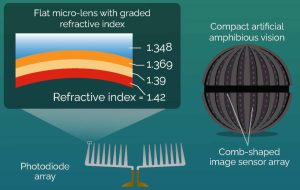 The eye of the fiddler crab has inspired an artificial image sensor that works on land and in water without refocusing.
The eye of the fiddler crab has inspired an artificial image sensor that works on land and in water without refocusing.
This crab moves freely between aquatic and terrestrial environments, and to be effective in both its eyes have flat corneas with a graded refractive index profile, according to the Gwangju Institute of Science and Technology in Korea, where the image sensor was created.
It also has an ellipsoidal eyes wrapped around stalks, giving it that 360° field of view.
“Research in bio-inspired vision often results in a novel development that did not exist before,” said Gwangju’s Professor Young Min Song. “This, in turn, enables a deeper understanding of nature and ensure that the developed imaging device is both structurally and functionally effective.”
The sensor consists of an array of flat-topped micro-lenses (diagram) with a graded refractive index profile, together optimised to keep light rays focusing on the same spot regardless of the refractive index of the surrounding environment.
Its graduated lens – from sensor to environment – has stacked layers of 1.42, 1.39, 1.369 and 1.348 refractive index.
The micro-lens array was created by micromachining a solid multi-faceted negative mould, and then pouring over it liquid transparent silicone (PDMS). Once set and removed from the mould, the bumpy silicon surface was successively spin-coated with the differing refractive index materials. Lens diameters from 17 to 500μm were tried.
For wrapping into a sphere, the flat sheet of micro-lenses was cut into a series of segments – to visualise the necessary shape, imagine cutting a globe along the lines of longitude, almost to the equator, and then unrolling it.
Before the lens array was wrapped onto the 20mm diameter spherical substrate, four comb-like shaped flexible PCBs (two in diagram bottom row), each holding 64 photo-diodes, was wrapped onto it to form the receiving part of the spherical sensor (right of diagram – spots are photo diodes).
The PCBs are a impressive in themselves, with eight LEDs evenly-spaced along each of the comb teeth, connected into an x-y matrix by double-sided tracks which bring the grid out to 16 terminations on the PCB flying lead.
“Amphibious imaging was performed by immersing the device halfway in water,” according to the Institute. To the researcher’s “delight, the images produced by the system were clear and free of distortions. The team showed that the system had a panoramic visual field, 300° horizontally and 160° vertically, in both air and water”.
GIST worked with Seoul National University, Pusan National University, University of Texas at Austin and MIT.
The work is published as ‘An amphibious artificial vision system with a panoramic visual field‘ in Nature Electronics – payment required to view the whole paper. The excellent associated supplementary information (viewable without payment) gives some idea of the novel precision engineering involved and is well worth a look.
Diagram provided by Gwangju Institute of Science and Technology in Korea.
Note: In the proof of concept, the high refractive (red) lens layer has a flat lower face to lay on the photo diodes
Note: This article has been written from multiple sources and may contain errors, Electronics Weekly has requested a review from the research team – watch this space…
